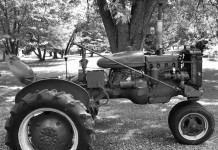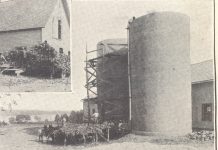Man works from sun to sun, but woman s work is never done.
This old saying certainly applied to the average farm wife in the 1850s. A list of her tasks would reach from here to there. She had to spin — they needed wool cloth for warm clothes and linen for shirts and underwear. Wood must be carried to heat up the outdoor oven — bread, pies, cakes and cookies, and even a chicken or two must be baked for the week.
Soon it would be wash day, and then the ironing and sewing. The milk had to be strained and the butter churned and salted. Her man had just butchered and there were hams and bacon to be smoked. Fruit must be quartered and dried for the coming winter. There were three meals to cook each day and cleaned up afterward, and the house needed swept and dusted, and the carpets taken outside and beaten. It never ended.
One view
One woman wrote the Prairie Farmer in 1857: “Woman is placed in the same category with infants, idiots, insane persons, slaves and incorrigible criminals and in the eye of the law she has no rights. She has no voice in making the laws by which she is governed. She may not acquire or hold property in her own right and her own fortune may be taken by a brutal, drunken, spendthrift husband and worse, a mother has no right to her own children.”
After the Civil War, during which many women shouldered the duties of their absent husbands, as well as their own, the winds of change began to blow softly. The industrial growth of the period opened up some factory jobs to women, allowing them to earn their own money, even though it was less than men made.
In addition, labor-saving devices for the home became more plentiful. Mechanical washing machines and wringers appeared, as did carpet sweepers and better cooking stoves. Sewing machines had been used in garment factories, but small ones for home use became available. The safety pin was invented in 1869.
During the 1870s the typewriter and the telephone were invented and, although at first men were used as stenographers and operators, it wasn’t long before these jobs became almost exclusively woman’s work.
Activists
Susan B. Anthony, Elizabeth Cady Stanton and other influential women were agitating for women’s rights, much to the disgust of most men. A Mrs. Waite petitioned the courts for the right to vote in a Chicago election, but a Judge Jameson ruled against her, although women did vote in New Jersey and Utah in 1872.
Young women commenced to apply and be accepted into a few colleges and universities. From the farm papers of the day, we learn that 14-year-old Mary Somerlee, plowed, harrowed and planted 38 acres of corn on their Illinois farm, while a Mrs. Marshall, from Dubuque, Iowa, sold $2,250 worth of strawberries from her 3-acre patch.
Women were starting to make the news. Readymade clothes for men and boys were first offered in 1875. Also during this period, agitation against the adulteration of much of the food sold in grocery stores began. Women were tired of buying rancid butter, watered down milk with hair in it and stale crackers from the open cracker barrel where the store cat might be found sleeping.
Conveniences
During the 1890s, running water and bathrooms in the home were being recommended for farm homes, and the Sears, Roebuck and Montgomery-Ward catalogs brought to farm homes just about every imaginable product one could want.
In 1917, another war liberated women even more. As their men marched off to fight the Hun, women took on many jobs formerly believed to be beyond them. False modesties began to fade and women began to wear clothes that were considered scandalous. Due to the requirements of certain jobs, some ladies were even seen wearing trousers, of all things!
In some farm areas, women were trained to drive tractors, acquiring the title of tractorettes. President Woodrow Wilson, initially against the idea of women voting, changed his mind and in 1918 made a speech promoting it. Congress finally passed the 19th amendment, giving women the right to vote in 1919, and ratification by the states followed in 1920.
Flappers danced their way through the Roaring Twenties, but there wasn’t much dancing for the decade between 1929 and 1941, until the second World War brought back prosperity, as well as lots of work for women in factories and on farms.
After the war, the improvements kept coming, with better and more home appliances, pre-packaged foods and readymade clothes. Women had more leisure and more jobs were opening for them. Before long, the stay-at-home Mom was a rarity, and most women worked somewhere.
Presently
The role of women has changed drastically in the century and a half since our farm wife wrote in 1857: “… in the eye of the law she has no rights.”
I imagine there are few ladies today who would care to go back to those long-ago days, although some men might. So this Thanksgiving, when you re popping that perfect Honeysuckle turkey into the electric range oven, or maybe even ordering a to-go turkey dinner with all the trimmings for 10 people from Bob Evans, pause to think of your great-grandmother in her apron, axe in hand, out in the yard coaxing the big tom turkey to come close enough to grab.












